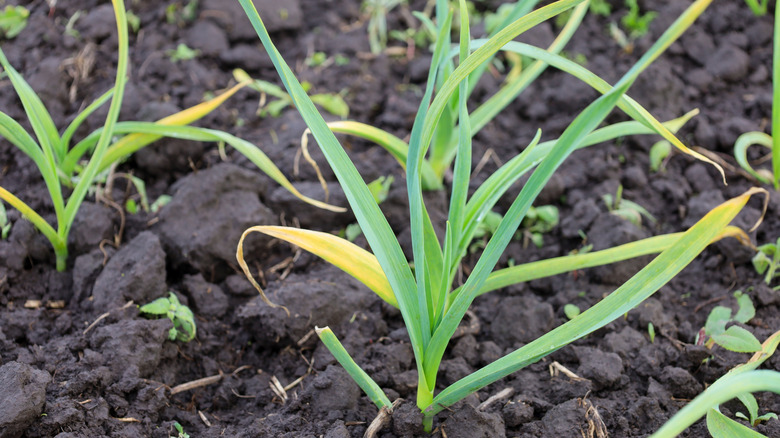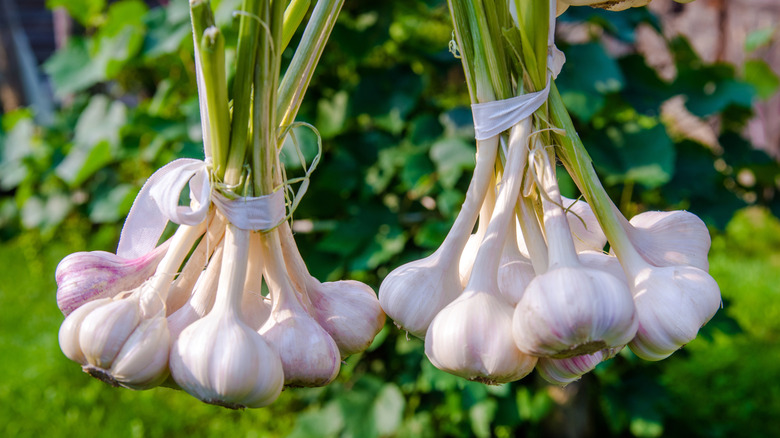Why The Garlic From Your Garden Looks Yellow And How To Prevent It
Growing garlic takes serious patience — up to 10 months in some cases. But once you finally pull fully matured garlic from the ground, you can slice the cloves in different ways (it affects the taste), turn it into a magical roasted garlic compound butter, or simply use it elevate any dish (roasted garlic and apricot chicken, anyone?) — and suddenly all the waiting feels worth it. However, if you're still in the growing stage and your garlic leaves start to turn a sickly yellow, a few factors could be at play. Dusty Vauters, ATV sprayer manager at MidSouth, explained to Food Republic that it might be due to "inconsistent watering, nitrogen deficiency, pests, or fungal diseases like rust or white rot."
For example, garlic plants that receive too much water might yellow all over, with stems turning squishy. But if you're underwatering, just the tips of the leaves may start to yellow, often curling upward as well. It's important to water consistently — not too often, not too little.
Timing matters, too. According to Vauters, consistent, uniform yellowing early in the season usually points to a nitrogen deficiency. "But it is easily fixable with balanced fertilizer or compost," he said. He added that you can address this issue by applying a nitrogen-rich compost early in the season, preventing the soil from becoming soggy, and mulching heavily to help regulate moisture and temperature. "Check plants regularly for pests or fungal issues and remove affected leaves promptly," he advised.
More causes and fixes for yellowing garlic leaves
Dusty Vauters also shared a few other common causes of yellowing garlic leaves and how to identify them. Examining the pattern on the leaves can help you determine what's going on. Yellowing that looks patchy, streaked, or spotted suggests pests or disease. In this case, you can use a targeted treatment, such as neem oil in a spray bottle with the nozzle set to stream, to deter insects.
If there are no pests but disease is the culprit, solarizing the soil can help kill white rot, one of the more common fungal threats to alliums. For another major disease, downy mildew, installing drip irrigation lines can prevent overhead watering, since water sitting on leaves too long is a big factor in its spread.
Finally, if your leaves are yellowing late in the season, like in summer after planting, Vauters explained: "That's just natural aging as the plant finishes its growth cycle." In fact, it's a good sign — it means your garlic is ready, or nearly ready, for harvesting.
Prevent yellowing garlic with soil preparation
The ground you put your garlic in is the number one factor in your plants' health, and it can make or break your harvest every year, so it's important to prepare it and tend to it properly. "Garlic thrives in well-drained, nutrient-rich soil[,] and as part of a yearly crop rotation," Dusty Vauters explained.
He advised gardeners to lay down a layer of compost rich in nitrogen and amend it into the existing soil before planting. This also helps keep the soil from becoming too water-logged, since the addition of compost, plus some deep digging and manual loosening before planting, keeps the ground aerated. That way, water drains through more easily, and the soil avoids becoming too compact, which can lead to stunted, undersized garlic bulbs.
Plant your garlic only once in the same spot within at least a four-year period as a way to reduce the likelihood of disease. With proper soil preparation and these tips in mind, you can look forward to a copious garlic harvest and enjoy your homegrown bulbs in all your favorite meals.



